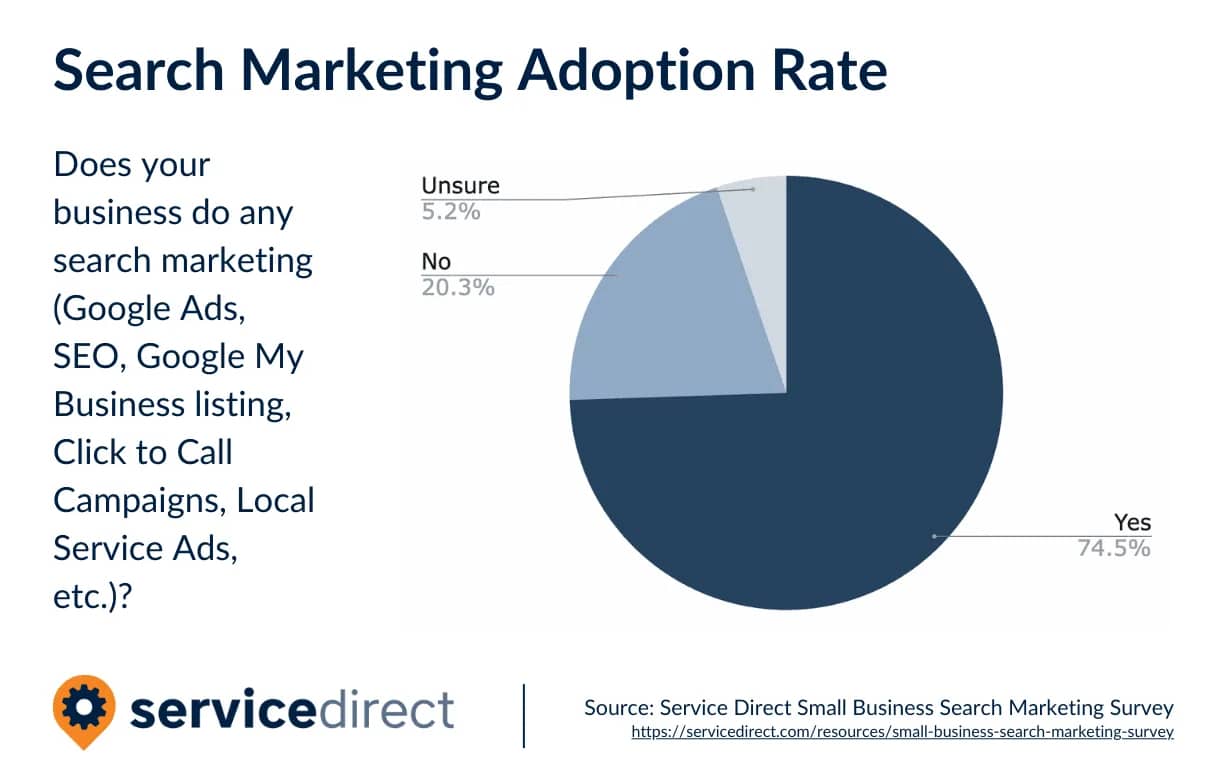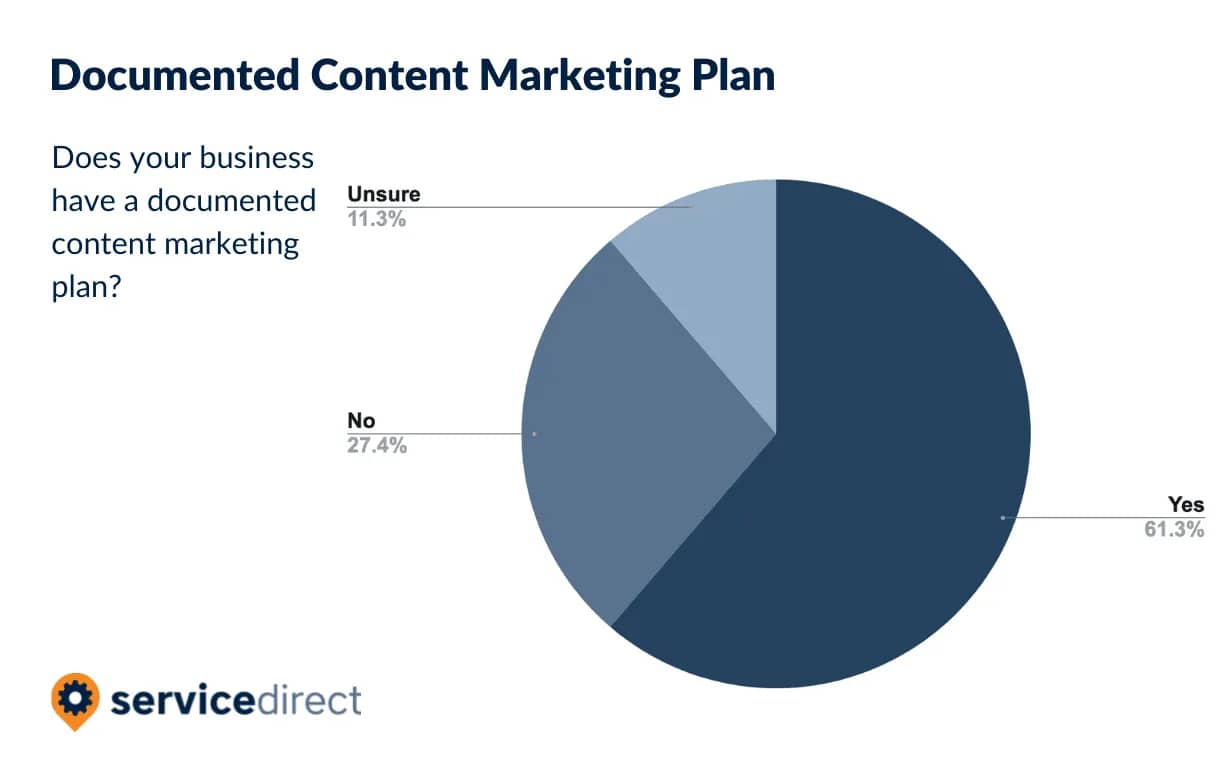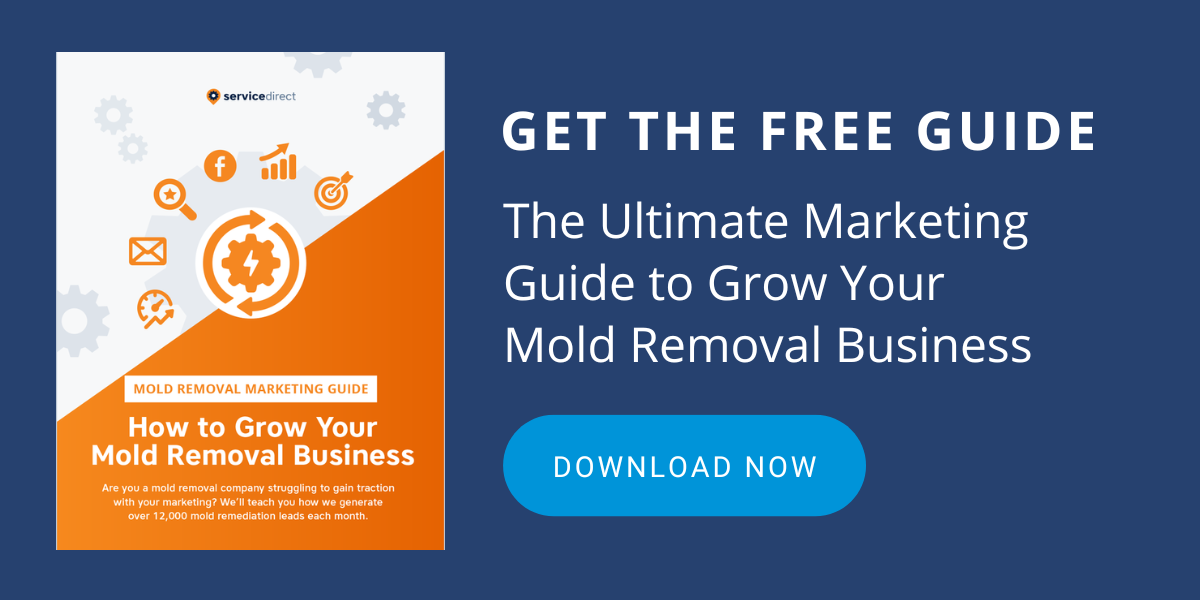Marketing Your Mold Remediation Business Online
Mold remediation businesses have a unique opportunity when it comes to marketing. Because their services are in high demand, they can be more selective with the marketing techniques they use.
Based on a survey we conducted, nearly 75% of small businesses use search marketing tactics in their overall business strategy. This means that if you want to keep up with the competition you need to be implementing key marketing efforts in your day-to-day.

In this blog post, we will discuss how mold remediation businesses can create a successful marketing plan that will help them stand out in their market.
How to craft a marketing plan for your business
When most people think of marketing, they think of commercials on television or billboards on the side of the road. However, marketing is so much more than just advertising.
A comprehensive marketing plan considers all aspects of your business, from your target market to your competition. It also outlines your goals and objectives and provides a detailed plan for how you will achieve them.
By developing a marketing plan, you can ensure that your mold removal company is getting the most out of its marketing efforts. Plus, with 61% of businesses having a documented marketing plan in place, you can’t afford to miss that crucial step.

One of the main benefits of having a mold marketing plan is that it allows you to focus your efforts on your target market. When you know who your ideal customer is, you can craft messages that appeal directly to them.
This laser-like focus can lead to a significant increase in leads and sales. In addition, a well-defined target market can help you save money on advertising and other marketing expenses.
Another benefit of having a marketing plan is that it provides a roadmap for success.
Without a plan, it can be challenging to measure the results of your marketing efforts. With a plan in place, you can track your progress and adjust your strategy as needed to ensure that you are achieving your desired results.
Now that we've discussed the benefits of having a marketing plan, let's talk about how to create one. The first step is to define your mold removal business.
Identify Your Brand
When you sit down to create a marketing plan for your mold removal company, it's important that you have a clear idea of your business's mission statement and customer-facing business goals.
These are the foundation for everything else in the marketing plan and will be what you present to potential customers. Everything else in your marketing plan should support these 2 things.
If you can't seem to define either of these elements, take some time to brainstorm with your team. Once you have a clear idea of what you want to achieve, you can start writing your marketing plan and create an effective strategy for reaching your target audience.
Craft a Mission Statement
In the business world, a mission statement is defined as "a formal summary of the fundamental goals and objectives of a company." In other words, it is a brief description of what the company plans to achieve.
For mold removal businesses, crafting a mission statement is a crucial first step in connecting with potential customers via marketing efforts.
By clearly articulating the purpose and goals of the business, mold removal companies can more effectively target their marketing efforts and ensure that they are reaching the right audience.
Taking the time to define a mission statement will pay off in terms of better connecting mold removal businesses with their target market.
Set Your Goals
When it comes to mold removal marketing, it's important to have a clear goal in mind. This will help you monitor your progress and make necessary adjustments along the way.
All too often, businesses like yours have vague goals such as "bring in more leads." This may be a good place to start, but it's important to be more specific so that you can adequately measure your progress.
Here are some questions to ask yourself when setting your marketing goals:
-
What does success look like? How many leads do you want to bring in?
-
What is your budget? How much are you willing to spend on marketing?
-
Who is your target audience? What demographics are you trying to reach?
-
What methods will you use to reach your target audience? (Advertising, social media, email marketing, etc.)
We are huge fans of the Objective and Key Result (OKR) process for setting goals and tracking your progress toward them. OKRs are a really powerful way to help you understand where you want to go and how you can get there.

Answering these questions will help you better define your marketing goals and create a plan that is more likely to succeed.
Finding Your Target Audience
Understanding who your customers are is the first step in effective marketing. Your potential customers may include homeowners, landlords, property managers, and businesses facing mold issues.
Demographic details like age, gender, income, and location are essential. Keep in mind potential concerns about health and property value as well.
It can be helpful to create customer personas to help you tailor your marketing efforts. Customer personas are fictional characters that represent your ideal customers.

For example:
-
Homeowner Helen: Age 45, lives in a suburban area and is concerned about family health and home value.
-
Property Manager Paul: Age 38, manages multiple rental properties, and needs quick and efficient mold removal services.
Keep the customer journey in mind when identifying your target audience. The online journey for a customer seeking mold removal services is typically broken up into awareness, consideration, and decision stages.
Examples of the Customer Journey in Mold Remediation Situations:
- Awareness: Helen notices mold in her basement and searches online for "mold removal services."
- Consideration: She reads blog posts and watches videos about mold remediation.
- Decision: Helen contacts a mold remediation company after reading positive reviews and testimonials.
What's Your Position in the Market?
Now that you have a mission statement for your mold remediation company, it's important to dive into where you will position yourself within the market through your marketing efforts.
While mold removal is a high-demand service, there are likely multiple other companies in your area that provide similar services. Your market positioning is how you stand out.
There are a few key ways to go about this:
- Consider what unique selling proposition your company has. This could be anything from having the most experienced technicians to offering the most competitive rates. Whatever it is, make sure it is clear and concise.
- Think about what needs or pain points your target market has that you can address with your services.
- Once you have a strong selling proposition and you know what needs/pain points your target market has, you can begin developing targeted marketing campaigns that speak directly to them.
These can be blog articles, social media posts, or even ads. The key is to make sure your marketing efforts are aligned with your overall business goals so that you can effectively attract new customers and grow your business.
How to Analyze Your Competitors
Conducting a SWOT analysis (Strengths, Weaknesses, Opportunities, Threats) is a great way to understand your business’s position in the market.

A SWOT analysis might look something like this:
- Strengths: Experienced mold removal staff, quick response time.
- Weaknesses: Limited online presence.
- Opportunities: Growing awareness of mold-related health issues.
- Threats: Competitors with stronger digital marketing.
After your SWOT analysis, you can work on identifying the top players in your area. Look at their websites, social media, and customer reviews.
Evaluate what marketing strategies your competitors use. Do they have blogs? Are they active on social media? What keywords are they targeting? Use tools like SEMrush or Google Ads for detailed analysis.
Setting Up a Realistic Budget
Your marketing budget is one of the most important aspects of your mold remediation marketing plan—and one of the most difficult to nail down.
There are a lot of factors to consider, from the cost of advertising to the price of market research, and if you're not careful, it's easy to overspend. The key to avoiding overspending on your mold removal marketing plan is to take the time to develop a budget and then allocate your resources accordingly.
The average business spends 1.08% of its revenue on advertising. Depending on your revenue, this number could be significant or quite small.

If your marketing budget is leaning toward the smaller side, it can quickly get gobbled up by costs like advertising, website design, and market research. As a result, small businesses often have to get creative when it comes to marketing their products or services.
One way to stretch your mold removal marketing budget is to take advantage of free or low-cost marketing tools, such as social media or SEO. Another option is to focus your marketing efforts on a specific target audience like people who own homes older than 50 years.
By scaling your marketing efforts, you can get more bang for your buck and make the most of your limited budget.
Optimizing your Website for Your Mold Remediation Services
SEO (Search Engine Optimization) helps your website rank higher in search results, making it easier for customers to find you. Mold removal SEO is an essential part of your marketing strategy, with 83% of small businesses reporting it as effective.

Use tools like Google Keyword Planner to find relevant keywords such as "mold removal," "mold remediation services," and "emergency mold removal." Incorporate these keywords naturally into your website content.
To succeed with mold removal SEO, you’ll need to use both on-page and off-page strategies:
- On-Page SEO: Optimize your website’s title tags, meta descriptions, and content with targeted keywords.
- Off-Page SEO: Build backlinks from reputable sites and engage in local listings and directories.
Why Your Site Needs a Blog
A blog can significantly boost your SEO efforts and engage potential customers. Content marketing is key to establishing your expertise and building trust with your audience through your mold removal blog.

Types of Content That Attract and Engage Customers:
- Blogs: Write about mold prevention tips, health risks, and remediation processes.
- Videos: Show before-and-after footage of mold removal projects.
- Email Marketing: Send personalized communications to current and potential customers.
- Social Media: Engage with potential clients on websites like Facebook
Different Types of Mold Removal Digital Marketing
Digital marketing encompasses various strategies that can help small businesses like mold remediation services reach their target audience effectively.
Email Marketing
An email list is a valuable asset for any business. Start by collecting email addresses from customers through your website, social media, and during service calls. Offer incentives like discounts or free consultations to encourage sign-ups.
Mold Removal email marketing should provide value to your subscribers. Send regular newsletters that include tips on mold prevention, updates about your services, and special promotions.
Personalize emails by addressing subscribers by their names and tailoring content to their interests. Use email marketing tools to automate your campaigns. This helps maintain consistent communication and allows you to segment your audience for more targeted messaging.
Pay Per Click (PPC) Advertising
PPC advertising involves placing ads on search engines like Google or social media platforms. You pay a fee each time someone clicks on your ad. This method can drive immediate traffic to your website.
To maximize the effectiveness of your mold removal PPC campaigns, target keywords relevant to your services. Consider keywords like "emergency mold removal," "mold inspection," and "mold remediation services." Use PPC tools to find the best keywords.
Regularly monitor your mold removal PPC campaigns to track their performance. Metrics like click-through rates, conversion rates, and return on investment are crucial. Adjust your ads, targeting, and budget based on these insights to optimize your results.
Content Marketing
A content calendar helps you plan and organize your marketing efforts. Schedule blog posts, social media updates, and email campaigns in advance. Consistency is key to keeping your audience engaged and informed.
Positive reviews and testimonials are powerful tools. Share these on your website, social media, and in your email campaigns. They build trust and credibility, showing potential customers that you provide excellent service.
Local SEO
Local SEO focuses on optimizing your online presence to attract local customers. Claim and verify your Google Business Profile. Ensure your NAP (Name, Address, Phone number) information is consistent across all platforms, including your website and online directories.
Encourage satisfied customers to leave reviews on Google and other review sites. Use local keywords in your content, such as "mold remediation in [Your City]" to improve your visibility in local search results.
Should I hire a Mold Removal marketing Agency?
Hiring a marketing agency can be a strategic move for your business. Agencies have the expertise and resources to create and manage comprehensive marketing campaigns.
They can help you with SEO, content creation, social media management, and more. This allows you to focus on your core business while ensuring your marketing efforts are in expert hands.
How Service Direct Can Help You Meet Your Marketing Goals
At Service Direct we specialize in helping small businesses grow through effective digital marketing strategies. We offer tailored solutions to meet your specific needs, from improving your website’s SEO to managing PPC campaigns.
With our help, you can reach your target audience more efficiently and convert leads into loyal customers!
Author's note: This post was originally published in September 2022 and has been updated to reflect current market trends and data.
FAQs About Marketing A Mold Remediation Business Online
What Are the Key Components of Identifying My Brand?
Identifying your brand involves establishing a unique brand identity that differentiates your mold remediation services from competitors. Key components include developing a unique logo, consistent branding across all platforms, and a clear, compelling mission statement that resonates with your target audience.
How Do I Create an Effective Mission Statement?
An effective mission statement clearly articulates the purpose and values of your business. It should be concise, memorable, and reflect your commitment to providing high-quality mold remediation services. Start by defining your core values, outlining your business goals, and ensuring the statement aligns with your brand identity.
What Are Some Common Marketing Goals for Mold Remediation Businesses?
Common marketing goals for mold remediation businesses include increasing brand awareness, generating leads, improving customer retention, enhancing online visibility, and driving more traffic to your website. Setting specific, measurable, achievable, relevant, and time-bound (SMART) goals can help in tracking progress and achieving success.
Why is Conducting a SWOT Analysis Important for My Business?
Conducting a SWOT analysis is important as it helps identify your business’s Strengths, Weaknesses, Opportunities, and Threats. This analysis provides insights into areas where you can improve, opportunities to leverage, and potential threats to address, allowing you to develop effective strategies to stay competitive in the mold remediation market.
How Can SEO Improve My Mold Remediation Website?
SEO (Search Engine Optimization) improves your website’s visibility on search engines, making it easier for potential customers to find your services. By targeting relevant keywords, optimizing on-page elements, and building high-quality backlinks, you can attract more organic traffic to your website, increasing the chances of converting visitors into customers.
What Types of Content Should I Include on My Mold Remediation Blog?
Your blog should include a variety of content that attracts and engages visitors, such as informative articles, how-to guides, case studies, customer testimonials, and engaging videos. Content marketing helps establish your authority in the industry, build trust with potential customers, and improve your website’s SEO performance.
How Effective is PPC Advertising for Mold Remediation Services?
PPC (Pay-Per-Click) advertising is highly effective for mold remediation services as it allows you to target specific keywords related to your business. With PPC, you can reach potential customers who are actively searching for mold remediation services, driving targeted traffic to your website and increasing your chances of generating leads.
Should I Hire a Content Marketing Agency for My Mold Remediation Business?
Hiring a content marketing agency can be beneficial if you lack the time or expertise to create high-quality content consistently. An agency can help develop a content strategy, produce engaging content, and manage your content marketing efforts, allowing you to focus on running your business while still benefiting from effective marketing.




